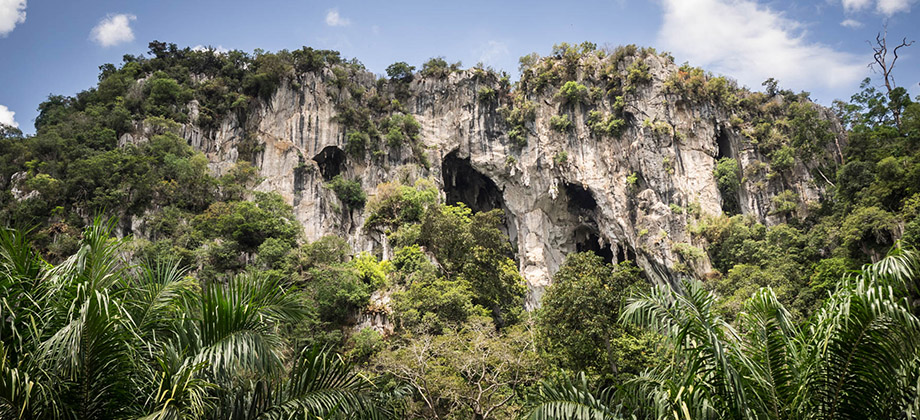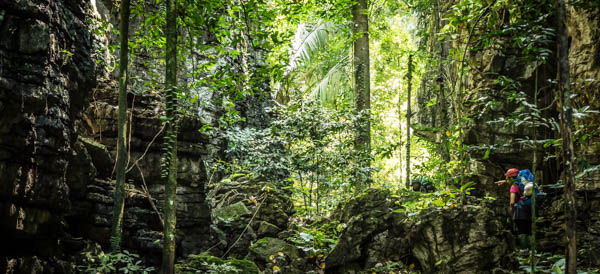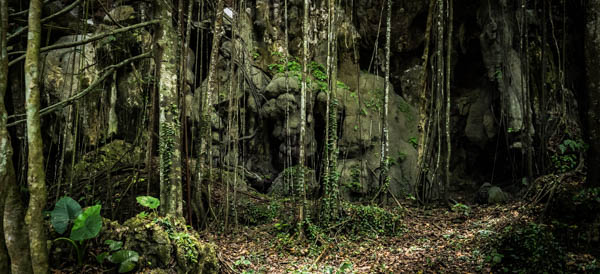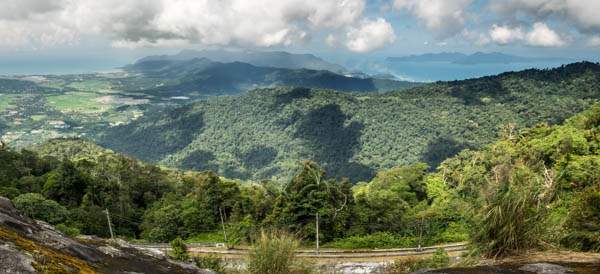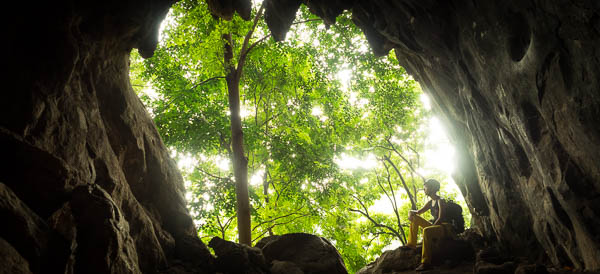Senyum Caves
Speleothems (Continued)
The next day, we made our way back through Angin cave, but took the right turn instead. There was an enormous boulder that stood in the middle of the passageway that we first had to bypass, but as soon as we did, the enormity and vastness of the Taman cave (English: Park cave) opened up to us. The ground was covered with soft earth and the giant-elephant-ear-lined (Colocasia gigantea) (Malay : Keladi Gajah) path was wide and clear, almost as if it were occasionally swept. The massive chamber was surrounded by a variety of plants of different shapes and sizes, and was lined by towering, sheer walls that were punctuated by magnificent arches. The ceiling was covered by an impressive amount of stalactites and flowstones; the chamber was also very well-lit, so we were not only able to hear the many chitterings of roundleaf bats (Hipposideros sp.) as they flew from cranny to cranny, but were able to easily see them as well.


splattermite, a type of stalagmite that is common in tall cave chambers in the tropics
The first chamber was called 'Gua Taman Satu', but walking a little further past the many rocks and boulders brought us to 'Gua Taman Dua'. This second 'garden' contained massive conical splattermites, resembling upturned pine tree cones, that were many metres high. Looking closer revealed multiple tiers that circled the periphery of the cone, with some tiers exhibiting ridges that tapered down from them like dangling tendrils, or melted rock that had solidified. When water drops hit the cave floor or the tip of a growing stalagmite, the shock of the collision disperses the water and leaves the calcium carbonate (CaCO₃) deposits behind. These deposits go on to form thin, stratified tiers, with any excess water accumulating over time and flowing over the sides, hence the 'tendrils'.

The next cave that we came across was Elephant cave. Unfortunately, the cave was off-limits due to an accident that happened a number of years ago, where a man fell through a sinkhole and slid down to a subterranean lake 30-40 metres or so below. We stood at the entrance for a short while trying to visualise the network of tunnels and chambers that lay hidden beneath our feet, before continuing along the path that brought us to the steep and very narrow stairwell to Makam Tok Long cave (English : Cave of Tok Long's Tomb).

According to local legends, supernatural beings used to inhabit these caves. These beings, referred to as 'Orang Bunian' in Malay, were invisible to all humans except for a gifted few. Tok Long was one of these gifted men, and he ended up falling in love with one of the bunian females. Before the couple were to be married, however, the bunian female had to fulfill three conditions: She had to bathe in one of the pools of the Kolam Tujuh cave, make her way to Angin cave where she was to dry her body in the wind that was channeled through the entrance, and then had to enter Terang Bulan cave to bask in the bright beam of moonlight that pierced through the roof of the cave. Only once these three conditions were met was she permitted to wed Tok Long.
The couple eventually were wed, but as time went by, Tok Long began to miss his family back home in Kuala Krau. He asked for his wife's permission to return home for a short visit, which was granted, but only on the condition that Tok Long was to return to her before a whole month had passed. Tok Long returned to Kuala Krau, but as time went by, he forgot the promise that he had made to his wife. He rushed back to the Senyum caves as soon as he remembered, but alas, he was several days too late and his wife was no longer there. Tok Long spent the rest of his days waiting in the caves for his bunian wife to return.

The Makam Tok Long cave not only contains the main burial site, but also the remains of multiple fenced-off excavation sites. These caves were first excavated for mesolithic and neolithic remains way back in 1917 by I. H. N. Evans, but I was unable to determine whether the fenced-off excavation sites in Tok Long's cave had anything to do with Evan's excavation. We passed through the multi-level passageway just behind the burial site, and then through a very tight squeeze-hole. This eventually brought us to the final cave of the day, Silat cave--the name of the cave having been derived from a class of South-East Asian martial arts. The entrance of the cave drops down to a flat, sandy floor that was said to have been used as both a place for meditation as well as a training area for practitioners of the martial art.


